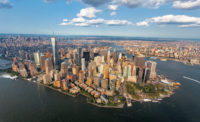The creators of the Lowline, a proposed park below Delancey Street on New York’s Lower East Side, have received a major show of support from the New York City Economic Development Corporation (NYCEDC).
Last fall, the NYCEDC issued a request for expressions of interest (RFEI) for reusing an abandoned trolley terminal below Delancey Street. The RFEI elicited just one response, from the Lowline organization, according to NYCEDC spokesman Stephanie Baez. Yesterday, the NYCEDC gave the Lowline its “conditional designation” as lessor of the underground space.
"The trolley terminal is a challenging and immensely complicated site," Ms. Baez said. "We extended the RFEI deadline an additional two months and offered tours to give more groups the opportunity to respond. We would have certainly liked more responses, but didn’t receive any."
The Lowline’s founders, James Ramsey and Dan Barasch, first proposed the subterranean park in 2011, and they been experimenting with ways of carrying concentrated light through tubes in order to grow elaborate gardens in the terminal, which is owned by the city and has been abandoned for 80 years.
Reached on vacation, Barasch said he was "not entirely surprised" that the RFEI drew no other responses. ”No one had ever seen any value in this site before — not the MTA, not the City, not private developers," he said.
But the organizers have a long way to go before the dark gives way to park. In its conditional designation, the NYEDC required them to implement a robust community engagement plan, raise $10 million in the next 12 months, and present schematic design documents for approval by next summer.
Barasch said he was looking forward to "kicking off a robust design phase in the next few months" and estimated that the Lowline could open in 2021.
In 2013, the city chose a developer for Essex Crossing, a planned $1 billion-plus mixed used complex on the south side of Delancey Street. Essex Crossing includes an underground mall, which abuts the former trolley terminal. Barasch and Ramsey have been in talks with the developer, Delancey Street Associates, about connecting the Lowline and the new mall. In addition it is likely that “light concentrators,” needed to bring sunlight to the Lowline gardens, would be placed on Essex Crossing buildings. Goldman Sachs, a major investor in Essex Crossing, has made donations to the Lowline.
In October 2015, Barasch and Ramsey opened the Lowline Lab, an aboveground simulation of the planned underground gardens. The Lab, at 140 Essex Street, is open to the public on weekends.
As for the real Lowline, Deputy Mayor for Housing and Economic Development Alicia Glen said: “We can’t wait to see this experiment unfold.”
This story was updated on 7/15/16 at 3:00 p.m. EDT to reflect new information.









Post a comment to this article
Report Abusive Comment